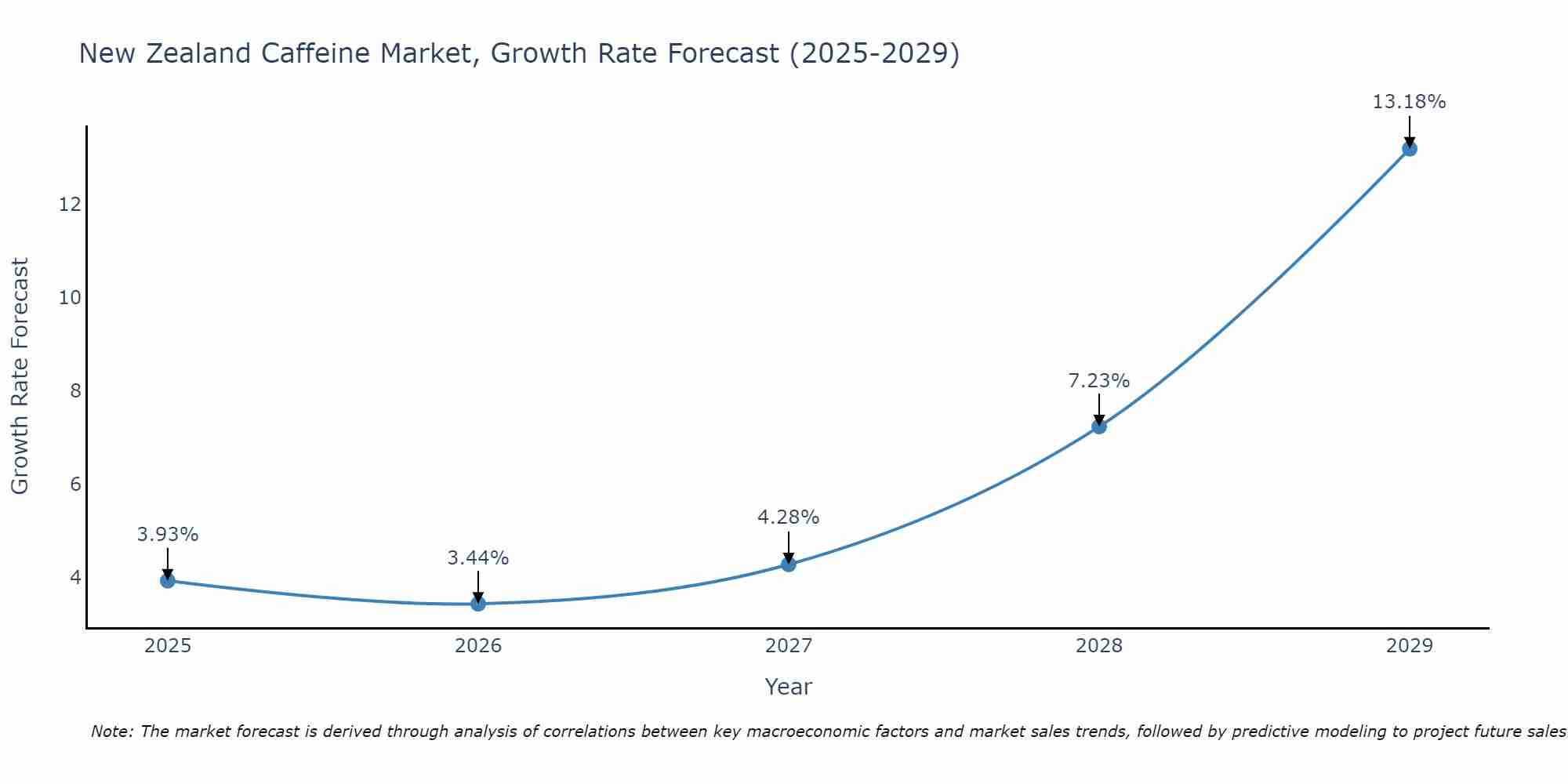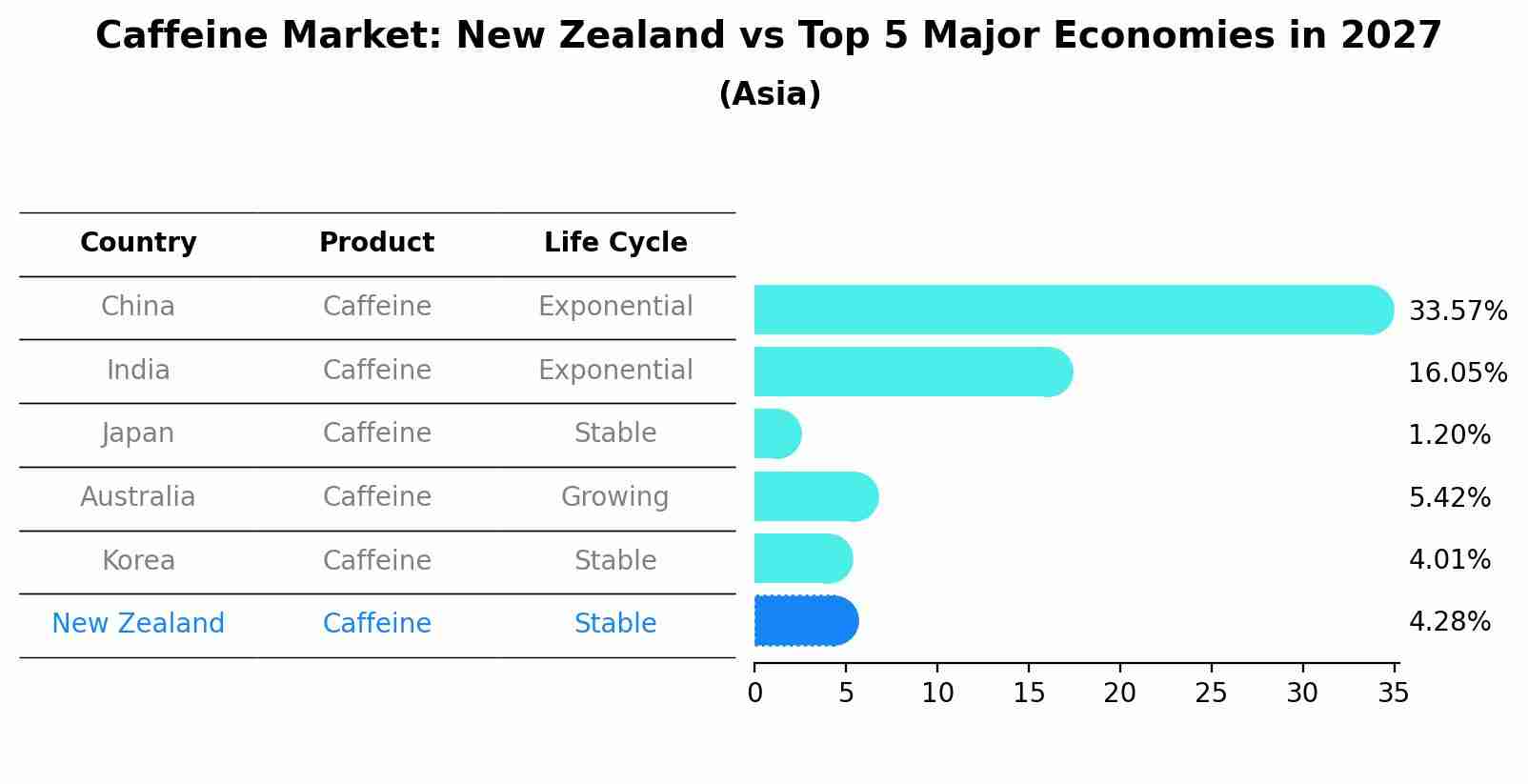New Zealand Caffeine Market (2025-2031) | Value, Size, Revenue, Forecast, Analysis, Trends, Growth, Share, Segmentation, Companies, Industry & Outlook
| Product Code: ETC4741794 | Publication Date: Nov 2023 | Updated Date: Sep 2025 | Product Type: Market Research Report | |
| Publisher: 6Wresearch | Author: Shubham Deep | No. of Pages: 60 | No. of Figures: 30 | No. of Tables: 5 |
New Zealand Caffeine Market Size Growth Rate
The New Zealand Caffeine Market is projected to witness mixed growth rate patterns during 2025 to 2029. From 3.93% in 2025, the growth rate steadily ascends to 13.18% in 2029.

Caffeine Market: New Zealand vs Top 5 Major Economies in 2027 (Asia)
By 2027, the Caffeine market in New Zealand is anticipated to reach a growth rate of 4.28%, as part of an increasingly competitive Asia region, where China remains at the forefront, supported by India, Japan, Australia and South Korea, driving innovations and market adoption across sectors.

New Zealand Caffeine Market Overview
The New Zealand Caffeine Market is influenced by the rising popularity of energy drinks and functional beverages. Consumers` growing preference for caffeinated products to boost energy and alertness is propelling market growth, alongside traditional consumption through coffee and tea.
Drivers of the market
Caffeine, a natural stimulant found in coffee, tea, and certain beverages, is widely consumed in New Zealand for its energizing effects. The caffeine market is driven by the growing café culture, increasing consumer preference for functional beverages, and the proliferation of coffee chains across the country. Manufacturers and retailers in the market focus on product innovation and marketing strategies to attract consumers and expand their market share.
Challenges of the market
The New Zealand Caffeine market grapples with fluctuating raw material prices and the need for sustainable sourcing practices. Regulatory compliance regarding the permissible levels of caffeine in various products is another challenge. Consumer preferences are also shifting towards natural and organic sources of caffeine, affecting market dynamics.
Government Policy of the market
Government regulations on food and beverage safety influence the caffeine market. Policies ensuring the safe use of caffeine in products and adherence to health standards impact market operations and consumer demand.
Key Highlights of the Report:
- New Zealand Caffeine Market Outlook
- Market Size of New Zealand Caffeine Market, 2024
- Forecast of New Zealand Caffeine Market, 2031
- Historical Data and Forecast of New Zealand Caffeine Revenues & Volume for the Period 2021-2031
- New Zealand Caffeine Market Trend Evolution
- New Zealand Caffeine Market Drivers and Challenges
- New Zealand Caffeine Price Trends
- New Zealand Caffeine Porter`s Five Forces
- New Zealand Caffeine Industry Life Cycle
- Historical Data and Forecast of New Zealand Caffeine Market Revenues & Volume By Type for the Period 2021-2031
- Historical Data and Forecast of New Zealand Caffeine Market Revenues & Volume By Natural Caffeine for the Period 2021-2031
- Historical Data and Forecast of New Zealand Caffeine Market Revenues & Volume By Synthetic Caffeine for the Period 2021-2031
- Historical Data and Forecast of New Zealand Caffeine Market Revenues & Volume By Applications for the Period 2021-2031
- Historical Data and Forecast of New Zealand Caffeine Market Revenues & Volume By Pharmaceuticals for the Period 2021-2031
- Historical Data and Forecast of New Zealand Caffeine Market Revenues & Volume By Food for the Period 2021-2031
- Historical Data and Forecast of New Zealand Caffeine Market Revenues & Volume By Beverages for the Period 2021-2031
- Historical Data and Forecast of New Zealand Caffeine Market Revenues & Volume By Flavors and Fragrances for the Period 2021-2031
- New Zealand Caffeine Import Export Trade Statistics
- Market Opportunity Assessment By Type
- Market Opportunity Assessment By Applications
- New Zealand Caffeine Top Companies Market Share
- New Zealand Caffeine Competitive Benchmarking By Technical and Operational Parameters
- New Zealand Caffeine Company Profiles
- New Zealand Caffeine Key Strategic Recommendations
Frequently Asked Questions About the Market Study (FAQs):
1 Executive Summary |
2 Introduction |
2.1 Key Highlights of the Report |
2.2 Report Description |
2.3 Market Scope & Segmentation |
2.4 Research Methodology |
2.5 Assumptions |
3 New Zealand Caffeine Market Overview |
3.1 New Zealand Country Macro Economic Indicators |
3.2 New Zealand Caffeine Market Revenues & Volume, 2021 & 2031F |
3.3 New Zealand Caffeine Market - Industry Life Cycle |
3.4 New Zealand Caffeine Market - Porter's Five Forces |
3.5 New Zealand Caffeine Market Revenues & Volume Share, By Type, 2021 & 2031F |
3.6 New Zealand Caffeine Market Revenues & Volume Share, By Applications, 2021 & 2031F |
4 New Zealand Caffeine Market Dynamics |
4.1 Impact Analysis |
4.2 Market Drivers |
4.2.1 Increasing consumer awareness about the health benefits of caffeine consumption |
4.2.2 Growing demand for specialty and premium coffee products |
4.2.3 Rise in the number of cafes and coffee shops in New Zealand |
4.3 Market Restraints |
4.3.1 Health concerns related to excessive caffeine intake |
4.3.2 Fluctuating prices of coffee beans impacting production costs |
4.3.3 Competition from substitute beverages like herbal teas and energy drinks |
5 New Zealand Caffeine Market Trends |
6 New Zealand Caffeine Market Segmentations |
6.1 New Zealand Caffeine Market, By Type |
6.1.1 Overview and Analysis |
6.1.2 New Zealand Caffeine Market Revenues & Volume, By Natural Caffeine, 2021-2031F |
6.1.3 New Zealand Caffeine Market Revenues & Volume, By Synthetic Caffeine, 2021-2031F |
6.2 New Zealand Caffeine Market, By Applications |
6.2.1 Overview and Analysis |
6.2.2 New Zealand Caffeine Market Revenues & Volume, By Pharmaceuticals, 2021-2031F |
6.2.3 New Zealand Caffeine Market Revenues & Volume, By Food, 2021-2031F |
6.2.4 New Zealand Caffeine Market Revenues & Volume, By Beverages, 2021-2031F |
6.2.5 New Zealand Caffeine Market Revenues & Volume, By Flavors and Fragrances, 2021-2031F |
7 New Zealand Caffeine Market Import-Export Trade Statistics |
7.1 New Zealand Caffeine Market Export to Major Countries |
7.2 New Zealand Caffeine Market Imports from Major Countries |
8 New Zealand Caffeine Market Key Performance Indicators |
8.1 Number of new coffee shops opened in New Zealand |
8.2 Percentage of consumers opting for premium coffee products |
8.3 Growth in per capita coffee consumption in New Zealand |
8.4 Number of new product launches in the caffeine market |
8.5 Percentage of consumers aware of the origin and quality of coffee beans used |
9 New Zealand Caffeine Market - Opportunity Assessment |
9.1 New Zealand Caffeine Market Opportunity Assessment, By Type, 2021 & 2031F |
9.2 New Zealand Caffeine Market Opportunity Assessment, By Applications, 2021 & 2031F |
10 New Zealand Caffeine Market - Competitive Landscape |
10.1 New Zealand Caffeine Market Revenue Share, By Companies, 2024 |
10.2 New Zealand Caffeine Market Competitive Benchmarking, By Operating and Technical Parameters |
11 Company Profiles |
12 Recommendations | 13 Disclaimer |
- Single User License$ 1,995
- Department License$ 2,400
- Site License$ 3,120
- Global License$ 3,795
Search
Related Reports
- Vietnam System Integrator Market (2025-2031) | Size, Companies, Analysis, Industry, Value, Forecast, Growth, Trends, Revenue & Share
- ASEAN and Thailand Brain Health Supplements Market (2025-2031) | Strategy, Consumer Insights, Analysis, Investment Trends, Opportunities, Growth, Size, Share, Industry, Revenue, Segments, Value, Segmentation, Supply, Forecast, Restraints, Outlook, Competition, Drivers, Trends, Demand, Pricing Analysis, Competitive, Strategic Insights, Companies, Challenges
- ASEAN Bearings Market (2025-2031) | Strategy, Consumer Insights, Analysis, Investment Trends, Opportunities, Growth, Size, Share, Industry, Revenue, Segments, Value, Segmentation, Supply, Forecast, Restraints, Outlook, Competition, Drivers, Trends, Demand, Pricing Analysis, Competitive, Strategic Insights, Companies, Challenges
- Europe Flooring Market (2025-2031) | Outlook, Share, Industry, Trends, Forecast, Companies, Revenue, Size, Analysis, Growth & Value
- Saudi Arabia Manlift Market (2025-2031) | Outlook, Size, Growth, Trends, Companies, Industry, Revenue, Value, Share, Forecast & Analysis
- Uganda Excavator, Crane, and Wheel Loaders Market (2025-2031) | Strategy, Consumer Insights, Analysis, Investment Trends, Opportunities, Growth, Size, Share, Industry, Revenue, Segments, Value, Segmentation, Supply, Forecast, Restraints, Outlook, Competition, Drivers, Trends, Demand, Pricing Analysis, Competitive, Strategic Insights, Companies, Challenges
- Rwanda Excavator, Crane, and Wheel Loaders Market (2025-2031) | Strategy, Consumer Insights, Analysis, Investment Trends, Opportunities, Growth, Size, Share, Industry, Revenue, Segments, Value, Segmentation, Supply, Forecast, Restraints, Outlook, Competition, Drivers, Trends, Demand, Pricing Analysis, Competitive, Strategic Insights, Companies, Challenges
- Kenya Excavator, Crane, and Wheel Loaders Market (2025-2031) | Strategy, Consumer Insights, Analysis, Investment Trends, Opportunities, Growth, Size, Share, Industry, Revenue, Segments, Value, Segmentation, Supply, Forecast, Restraints, Outlook, Competition, Drivers, Trends, Demand, Pricing Analysis, Competitive, Strategic Insights, Companies, Challenges
- Angola Excavator, Crane, and Wheel Loaders Market (2025-2031) | Strategy, Consumer Insights, Analysis, Investment Trends, Opportunities, Growth, Size, Share, Industry, Revenue, Segments, Value, Segmentation, Supply, Forecast, Restraints, Outlook, Competition, Drivers, Trends, Demand, Pricing Analysis, Competitive, Strategic Insights, Companies, Challenges
- Israel Intelligent Transport System Market (2025-2031) | Strategy, Consumer Insights, Analysis, Investment Trends, Opportunities, Growth, Size, Share, Industry, Revenue, Segments, Value, Segmentation, Supply, Forecast, Restraints, Outlook, Competition, Drivers, Trends, Demand, Pricing Analysis, Competitive, Strategic Insights, Companies, Challenges
Industry Events and Analyst Meet
Our Clients
Whitepaper
- Middle East & Africa Commercial Security Market Click here to view more.
- Middle East & Africa Fire Safety Systems & Equipment Market Click here to view more.
- GCC Drone Market Click here to view more.
- Middle East Lighting Fixture Market Click here to view more.
- GCC Physical & Perimeter Security Market Click here to view more.
6WResearch In News
- Doha a strategic location for EV manufacturing hub: IPA Qatar
- Demand for luxury TVs surging in the GCC, says Samsung
- Empowering Growth: The Thriving Journey of Bangladesh’s Cable Industry
- Demand for luxury TVs surging in the GCC, says Samsung
- Video call with a traditional healer? Once unthinkable, it’s now common in South Africa
- Intelligent Buildings To Smooth GCC’s Path To Net Zero













